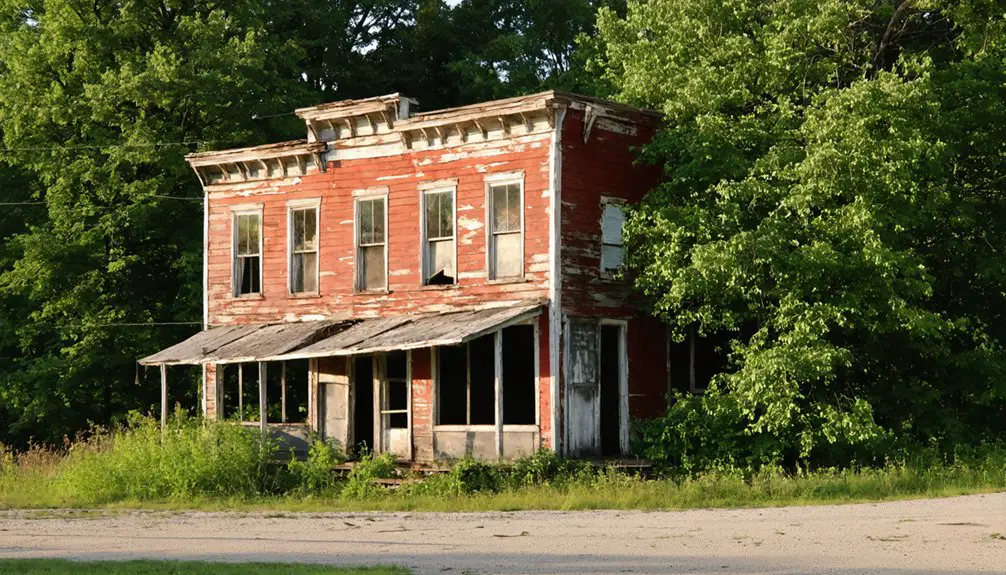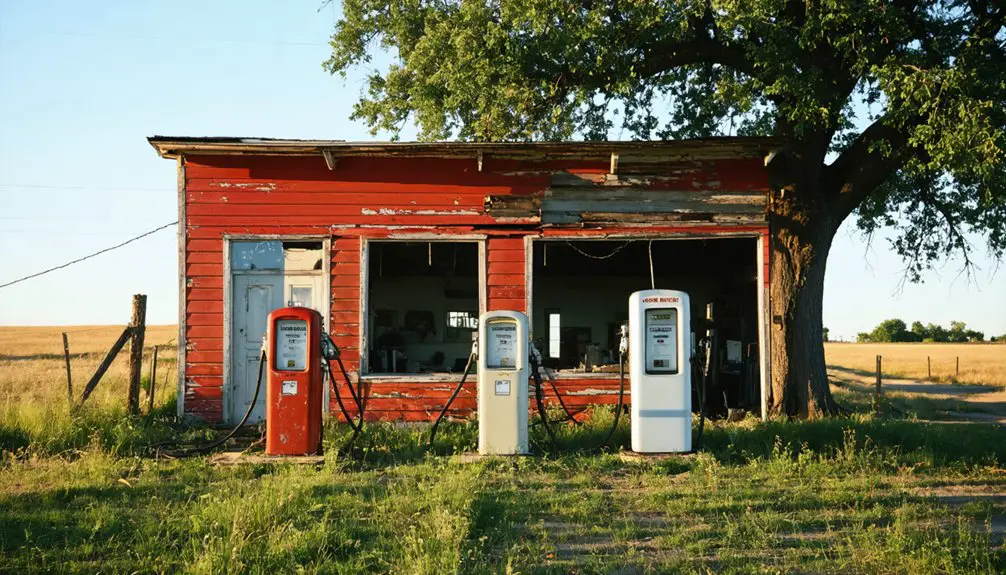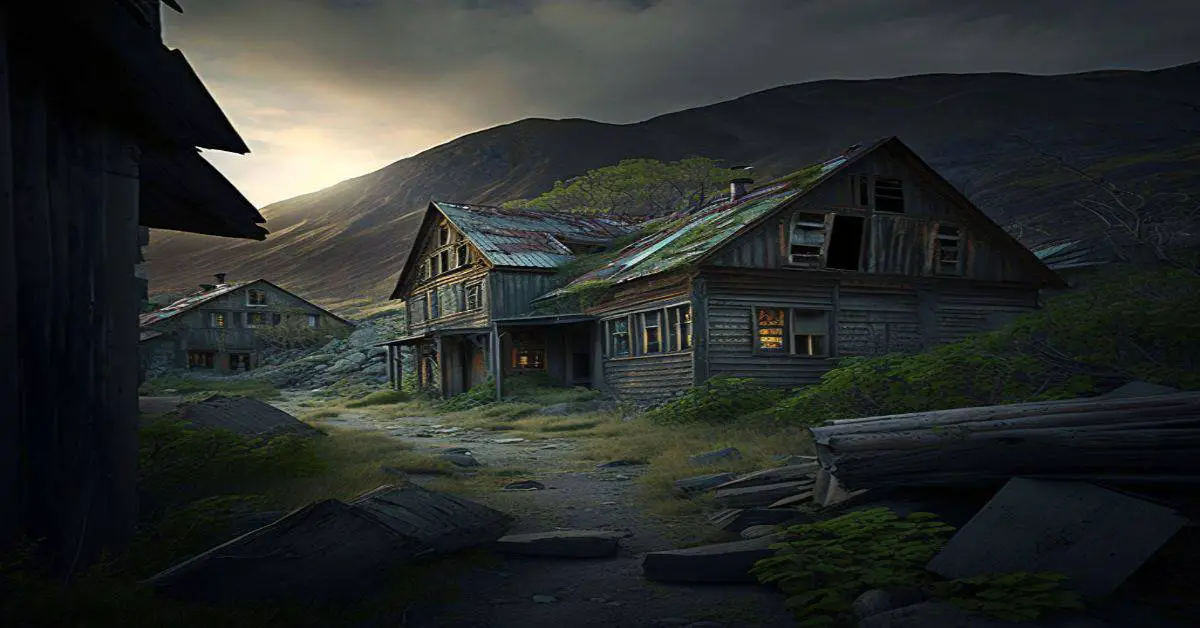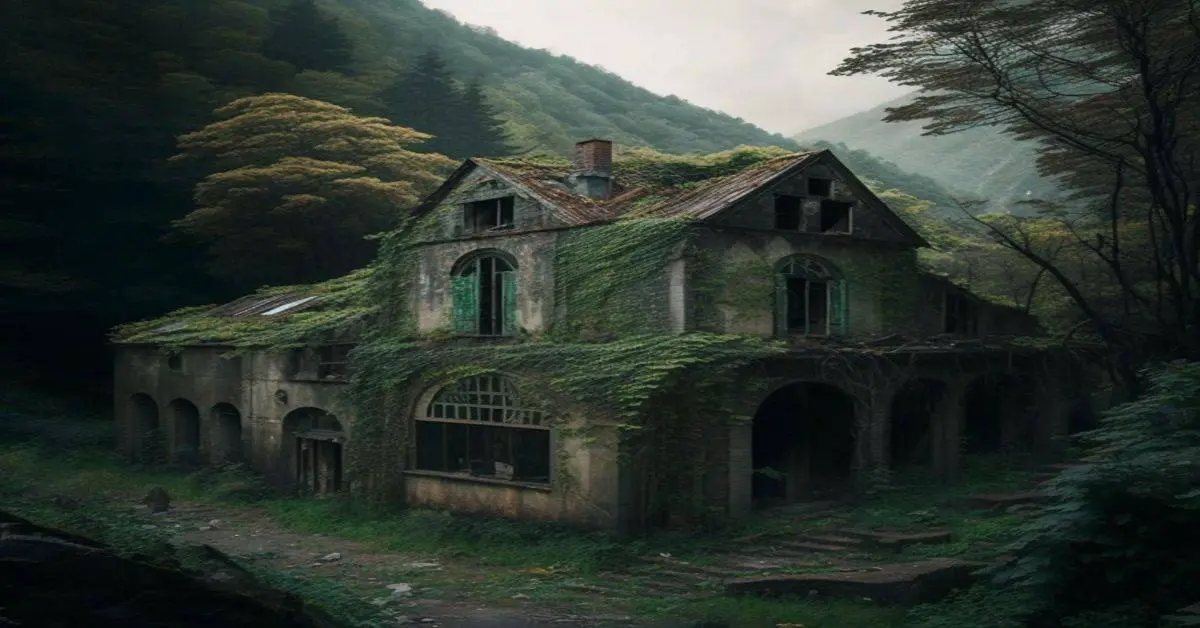You’ll discover Temple, Michigan’s compelling ghost town in the Upper Peninsula, where indigenous peoples first mined copper 7,000 years ago. After mineral discoveries in 1840, the settlement boomed, attracting Finnish, Irish, and Cornish immigrants who built a thriving community reaching 1,300 residents by the 1880s. The town’s decline began in 1898, and within two decades, fewer than 100 people remained. Today, weathered wooden structures and the Methodist Episcopal Church in Holbrook preserve this rich mining heritage.
Key Takeaways
- Temple transformed from a wilderness settlement into a booming copper mining town with 1,300 residents by the late 1880s.
- Indigenous peoples first mined copper there for 7,000 years before European settlement began in the 1600s.
- The town’s decline started around 1898, leading to rapid population loss and eventual ghost town status within two decades.
- Cultural remnants include Methodist Episcopal Church, weathered wooden structures, and architectural elements reflecting the mining era.
- The site now attracts tourists interested in ghost town exploration through self-guided visits and historical preservation efforts.
Mining Origins and Early Settlement
While indigenous peoples had mined copper in the Temple area for thousands of years, their ancient mining operations on Michigan’s Keweenaw Peninsula began at least 7,000 years ago.
Using stone tools and shallow pits, they mastered copper extraction from surface outcroppings, employing indigenous techniques like heating rocks with fire and quickly cooling them to cause fractures.
You’ll find evidence of this early mining heritage in the archaeological record, where native copper was transformed into tools, jewelry, and trade items that spread across North America.
Archaeological evidence shows that early miners created extensive pits and dumps while extracting copper from surface veins throughout the region.
When French explorers like Étienne Brule arrived in the early 1600s, they learned of these copper sources from the Ojibwa tribes.
The War of 1812 temporarily halted further exploration of the region’s rich copper deposits.
Though English miners attempted operations near the Ontonagon River in 1771, they failed due to poor planning and the region’s remote location.
Life During the Copper Boom Years
During Temple’s copper boom, you’d find a tight-knit community where miners and their families lived in basic wooden homes, often provided by the mining companies. The local miners had to carefully navigate separate track systems similar to those at Quincy Mine for ore cars and personnel transport.
You could see the strong influence of immigrant cultures, particularly Finnish, Irish, and Cornish traditions, which shaped everything from local churches to social gatherings and festivals. The workers came in waves, with early Irish miners arriving first before other European groups joined the workforce.
Your daily life in Temple would revolve around the mine’s schedule, with men working long underground shifts while families maintained households and participated in community events centered on mining celebrations and ethnic customs.
Daily Mining Town Life
Life in Temple’s copper mining town revolved around the demanding daily rhythms of underground work, where miners would climb nearly 1,000 feet of ladders carrying heavy tools before starting their shifts.
You’d find miners’ health constantly at risk as they worked in small teams, using hand drills and black powder to blast through rock in dangerous conditions that included fire hazards and cave-ins. The mines were exceptionally deep, reaching depths of over 9,000 feet underground.
Family dynamics centered around the company town’s infrastructure, where you’d live in company housing and shop at company stores. The modest homes had sawdust-covered windows to help insulate against the bitter winter cold.
You’d gather with other families at community halls for dances and social events, finding relief from the harsh realities of mining life.
The town’s immigrant population from Britain, Scandinavia, and Eastern Europe created a diverse community, though everyone shared the common thread of depending on the copper mines for survival.
Cultural Influences and Community
As Temple’s copper mining operations flourished, diverse immigrant communities from Finland, Cornwall, Italy, and Germany transformed the town into a vibrant cultural tapestry.
You’d find Finnish saunas dotting the landscape, while Cornish pasties became a favorite local dish. Each ethnic group maintained its unique identity while adapting to their new home through cultural assimilation. The town’s residents often enjoyed Slims Cafe pasties, a cherished culinary tradition that continues to this day.
The town buzzed with activity as ethnic festivals filled the streets throughout the year. You could hear multiple languages in the air while visiting the various churches, social halls, and community centers.
Catholic parishes served Italian families, while Lutheran churches welcomed Finnish congregants. Local theaters and dance halls provided entertainment, and sporting events brought everyone together.
Traditional music, from folk tunes to choir performances, echoed through Temple’s neighborhoods, creating lasting bonds between diverse residents.
Cultural Heritage and Immigrant Stories
In Temple’s early mining days, you’d find a rich tapestry of European workers, particularly Bohemian and Cornish immigrants, who brought their distinct cultural traditions to Michigan’s harsh frontier environment.
The mining families established strong community bonds through their churches, which served as both spiritual centers and educational institutions where immigrants could maintain their heritage while adapting to their new home. Similar to St. Mary’s Church in Phoenix, these places of worship became focal points for preserving cultural identity. Like the nearby Central Mine, the town supported a thriving church, school, and post office during its peak years.
You can still see evidence of these cultural connections today in the annual miners’ reunion services that have preserved community memories since 1907.
European Worker Communities
European immigrant communities brought rich cultural diversity to Michigan’s frontier settlements through waves of migration starting in the 1650s.
French and French Canadian settlers first established roots as fur traders, soldiers, and Jesuit missionaries, creating cultural foundations at Fort Michilimackinac and other outposts across the Upper Peninsula.
You’ll find that these early settlers shaped the region through their Catholic faith, French language, and trade networks.
After 1763, British control introduced new cultural exchanges, including Jewish merchants from Canada who joined the fur trade.
Immigrant groups formed tight-knit communities centered around shared language, religion, and economic activities.
They’d often cluster near mining operations, lumber camps, and farming regions, creating ethnic enclaves that preserved their European heritage while adapting to frontier life.
The discovery of mineral deposits in the 1840s brought thousands of Cornish and Irish immigrants who applied their mining expertise to the region’s developing industries.
Mining Family Traditions
While Michigan’s mining boom attracted diverse immigrant groups, the multi-generational experiences of mining families shaped distinct cultural traditions throughout the region.
You’ll find that Finnish immigrants like the Karna family balanced mining work at places like Champion Mine with farming in settlements like Tapiola, establishing generational legacies that blended occupational skills with agricultural knowledge.
Mining family dynamics centered around shared hardships and religious bonds, with Finnish Lutherans and Jewish families building strong community ties through institutions like Temple Jacob.
The daily routine of underground work, from climbing thousand-foot ladders to operating steam engines, fostered tight-knit family relationships. Families passed down not just mining techniques but also risk-taking traditions, as seen in the Workman and Temple families who diversified into oil and real estate ventures alongside their mining operations.
Cultural Gathering Places
Three essential cultural gathering places anchored immigrant life in Michigan’s mining communities during the 1840s mineral rush: churches, social halls, and ethnic clubs.
You’ll find these spaces played crucial roles in fostering cultural interactions among Finns, Swedes, and Norwegians who flocked to the Keweenaw Peninsula for mining work. Churches served dual purposes as worship centers and educational facilities, while social halls hosted traditional dances and celebrations that kept old-world customs alive.
The community’s resilience shines through in how they’ve maintained these gathering traditions.
Even today, you can witness this enduring spirit at Central Mine’s 155-year-old church, where annual reunion services draw hundreds of descendants.
These cultural hubs weren’t just buildings – they were lifelines that helped immigrants preserve their heritage while adapting to life in Michigan’s rugged mining towns.
The Town’s Rapid Rise and Decline

During the mid-1800s, Temple, Michigan transformed from untamed wilderness into a thriving copper mining settlement after geologist Douglass Houghton’s mineral discoveries sparked a rush in 1840.
The town’s economic factors quickly attracted immigrants worldwide, generating wealth ten times greater than the California Gold Rush. You’d have found a bustling community of 1,300 residents by the late 1880s, complete with hotels, saloons, churches, and daily mail service.
But Temple’s prosperity wouldn’t last. The social dynamics shifted dramatically when mines began closing around 1898.
Miners and their families left for opportunities in Cornwall, downstate Michigan, or points west. Within two decades, the population plummeted to fewer than 100 residents.
The harsh climate and isolation hastened Temple’s transformation into a ghost town.
Architectural Legacy and Remaining Structures
Among Temple’s architectural remnants, the Methodist Episcopal Church in Holbrook stands as the most prominent survivor, though its deteriorating walls tell the story of a once-thriving community.
You’ll find simple wood-frame construction typical of late 19th and early 20th-century rural Michigan architectural styles throughout the remaining structural remnants.
When exploring Temple’s ghost town sites, you’ll discover:
- Foundation ruins and scattered pottery shards marking where homes and businesses once stood
- Weathered wooden structures with plain window frames and gable roofs, built for function over form
- Stone foundations and chimneys peeking through overgrown vegetation, revealing the town’s original layout
The buildings’ dispersed arrangement reflects Temple’s adaptation to local industry, with structures strategically placed rather than tightly clustered in a traditional town center.
Ghost Town Tourism and Visitor Attractions
While Temple lacks extensive tourist infrastructure, you’ll find that its ghost town appeal draws visitors through a combination of self-guided experiences and regional support services.
You can begin your exploration at the Central Visitor Center in the Keweenaw region, where you’ll discover interactive exhibits, historical films, and self-guided tour brochures.
As you venture into Temple, you’ll navigate walking trails that weave through former town sites and mining areas, offering both scenic views and historical context.
While few structures remain, you can examine building foundations and trail ruins that attract hiking enthusiasts. The site’s interpretive signage and historical markers help you understand Temple’s copper mining heritage.
Young explorers increasingly discover the site through social media, joining traditional history buffs and photographers in experiencing this piece of Michigan’s mining past.
Historical Preservation Efforts Today
As Michigan’s State Historic Preservation Office leads statewide initiatives, Temple has benefited from increased preservation attention since 2014.
Historic preservation efforts now integrate modern technology to document and share Temple’s heritage, while preservation grants through MHPN support local projects to protect remaining structures.
You’ll find these key preservation developments in Temple:
- Digital mapping and documentation of historical buildings and sites
- Community engagement programs connecting visitors with Temple’s past
- Seasonal maintenance plans addressing harsh weather impacts on structures
The site’s preservation aligns with Michigan’s broader focus on protecting ghost town heritage, similar to efforts in the Keweenaw Peninsula’s mining communities.
While Temple isn’t as extensively preserved as some mining ghost towns, you’re witnessing growing interest in protecting its cultural significance through strategic conservation measures.
Frequently Asked Questions
Are There Any Dangerous Mine Shafts or Sinkholes Near Temple Today?
You’ll find mine safety is well-maintained, with historical shafts fenced and marked. While geological hazards exist from past mining operations, there’s no evidence of dangerous sinkholes threatening the area today.
What Items Have Treasure Hunters and Metal Detectorists Found in Temple?
Like prospectors panning for gold, treasure hunting and metal detecting enthusiasts have found rusted mining tools, old coins, jewelry pieces, bottle fragments, railroad spikes, musket balls, and pioneer-era personal items.
Does Anyone Still Legally Own Property or Land in Temple?
You’ll find property rights still exist for abandoned structures in Temple, though specific ownership records aren’t public. You’d need to check county records to confirm current legal landholders.
Are There Documented Paranormal Activities or Ghost Sightings in Temple?
Peculiarly peaceful, you won’t find verified ghost stories or documented paranormal sightings reports from Temple’s ruins. Despite Michigan’s rich haunted history, no credible evidence exists of supernatural activity in this location.
Can Visitors Take Artifacts or Souvenirs From Temple’s Ruins?
You can’t legally take artifacts or souvenirs from ruins – it’s prohibited. Practicing ethical artifact preservation guarantees everyone can experience these historical treasures, plus you’ll avoid fines and help protect cultural heritage.
References
- https://www.visitkeweenaw.com/blog/post/our-top-7-keweenaw-ghost-towns-to-explore/
- https://99wfmk.com/hamblen-holbrook/
- https://www.nps.gov/slbe/learn/historyculture/ghosttowns.htm
- https://gandernewsroom.com/2023/06/28/7-michigan-ghost-towns-you-might-not-find-on-your-map-2/
- https://www.smithsonianmag.com/history/once-a-year-this-19th-century-michigan-ghost-town-comes-to-life-180982695/
- https://www.geo.mtu.edu/KeweenawGeoheritage/BlackLavas/Copper_Mining.html
- https://www.youtube.com/watch?v=oxD6hQk0oz8
- https://www.nps.gov/kewe/learn/historyculture/index.htm
- https://www.nps.gov/kewe/learn/historyculture/copper-mining-timeline.htm
- https://npshistory.com/publications/kewe/hrs.pdf


